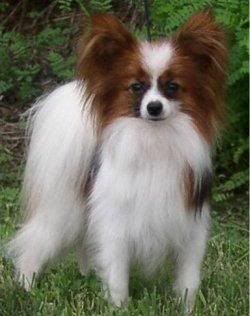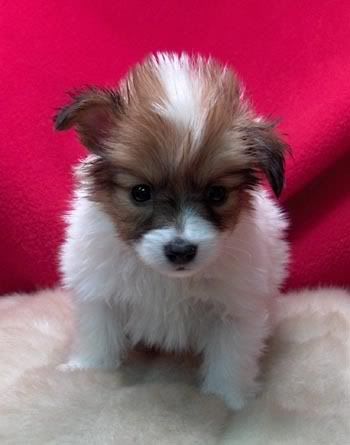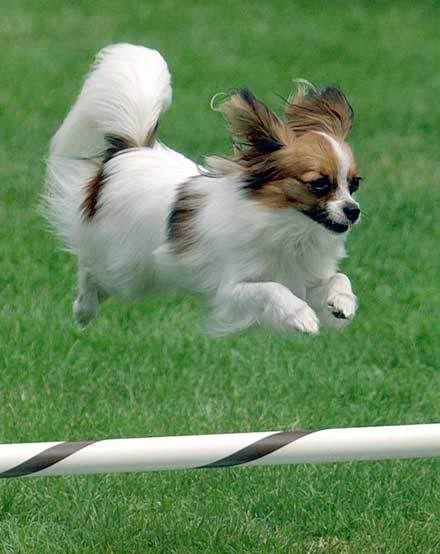Post by charmingnancy on Jan 6, 2009 13:35:47 GMT -5
Papillon
Group: 5- Toys
Origin: France, Italy, Spain and Belgium
Purpose: Papillons were bred for companionship, and make excellent watch dogs.

Description:
Papillons are known for their large, butterfly-like ears. The Papillon is one of the oldest of the toy Spaniels.
Appearance- Breed Standards:
Coat and Colour:
Coat- Abundant, long, fine, silky, flowing, straight with resilient quality, flat on back and sides of body. A profuse frill on chest. There is no undercoat. Hair short and close on skull, muzzle, front of forelegs and from hind feet to hocks. Ears well fringed with the inside covered with silken hair of medium length. Backs of the forelegs are covered with feathers diminishing to the pasterns. Hind legs are covered to the hocks with abundant breeches (culottes). Tail is covered with a long flowing plume. Hair on feet is short but fine, tufts may appear over toes and grow beyond them forming a point.
Colour-
Particolour- white with patches of any colour.
Tri-colour - black and white with tan spots over eyes, inside the ears, on cheeks, and may have tan under root of tail. On the head, colour other than white must cover both ears, back and front, and extend without interruption from the ears over both eyes. A clearly defined white blaze and nose band are preferred to a solidly marked head. Symmetry of facial markings is desirable. The size, shape, placement, or absence of patches on the body are without importance. Papillons may be any particolour, provided nose, eye rims and lips are well-pigmented black. Among the colours there is no preference.
Head: Small. The skull of medium width, and slightly rounded between the ears. A well-defined stop is formed where the muzzle joins the skull. The muzzle is fine, abruptly thinner than the head, tapering to the nose. The length of the muzzle from the tip of the nose to stop is approximately one-third the length of the head from tip of nose to occiput. Nose: black, small, rounded and slightly flat on top. Mouth: lips are tight, thin, and black Teeth meet in a scissors bite. Tongue must not be visible when jaws are closed. Eyes: dark, round, not bulging, of medium size and alert in expression. The inner corner of the eyes is on a line with the stop. Eye rims black. Ears: the ears of either the erect or drop type should be large with rounded tips and set on the sides and toward the back of head. Ears of the erect type are carried obliquely and move like the spread wings of a butterfly. When alert, each ear forms an angle of approximately 45 degrees to the head. The leather should be of sufficient strength to maintain the erect position. Ears of the drop type, known as Phalene, are similar to the erect type but are carried drooping and must be completely down.
Neck: Of medium length.
Forequarters: Shoulders well developed and laid back to allow freedom of movement. Forelegs slender, fine-boned and must be straight. Removal of dewclaws on forelegs optional.
Body: Must be slightly longer than the height at withers. It is not a cobby dog. Topline straight and level. The chest is of medium depth with well-sprung ribs. The belly is tucked up.
Hindquarters: Well developed and well angulated. Hocks inclined neither in nor out. The hind legs are slender, fine-boned, and parallel when viewed from behind. Dewclaws, if any, must be removed from hind legs. Feet are thin and elongated (hare-like), pointing neither in nor out.
Tail: Long, set high and carried well arched over the body. The plume may hang to either side of the body.
Gait: Free, quick, easy, graceful, not paddle-footed, or stiff in hip movements.
Faults: The following faults shall be severely penalized:
(a) Nose not black.
(b) Colour other than white not covering both ears, back and front, or not extending from the ears over both eyes. A slight extension of the white collar onto the base of the ears or a few white hairs interspersed among the colour shall not be penalized provided the butterfly appearance is not sacrificed.
(c) Overshot or undershot teeth.
(d)Ears small, pointed, set too high, one ear up or ears partly down, set too low.
(e) Low-set tail, one not arched over back or too short.
Disqualifications:
Height under 8 inches (20 cm) or over 12 inches (30 cm). An all-white dog or a dog with no white.
Size:
Ideal height at highest point of shoulder blades, 8-11 inches (20-28 cm). Weight is in proportion to height.

Temperament:
The Papillon has the appearance of a dainty toy breed, but many owners will claim that their dogs are "big dogs in little dog suits". Some people find that their Papillon is very capable of handling a good five-mile walk. One aspect of the Papillon that has led many to believe the "big dog" assertion is this breed's surprising athletic ability. Perhaps people are surprised that in contrast to its staid and stately representation in the Old Master portraits, the Papillon is highly energetic and intelligent.
Health:
Common health issues include kneecap and joint problems and difficulty under anesthesia. Fairly low maintenance, Papillons just need regular brushing. They shed twice a year. Also, their nails should be clipped and teeth cleaned now and then to prevent tartar buildup. They are also prone to seizures.
Average Lifespan:
A healthy Papillon can live as long as 16 years.

History:
The Papillon gets its name from ears that resemble butterfly wings. It is one of the oldest breeds of dog, with a recorded history in Europe going back nearly 700 years. Originating in France, the breed was then called the epagneul nain, or dwarf spaniel, and sported spaniel-type dropped ears. It was very popular with the European aristocracy. The court of France's Louis XIV was particularly fond of papillons and imported many of them. Recognizable in Italian frescoes of the 13th through 15th centuries, the tiny breed was featured in many paintings of the Renaissance period. Much of the papillon's development is known because of its depiction in paintings.
Although the breed is known for its resemblance to a butterfly, it has also been likened to a squirrel because of the way it carries its tail. Although the early dogs had drooping ears, an unknown event caused some dogs to sport erect ears. Sometimes both drop- and erect-eared papillons came from the same litter. Today, both ear types are correct according to the breed standard, although the erect-eared dog is much more popular. The drop-earred dogs are known as phalene, which is French for moth. By 1900, the papillon was well represented at French dog shows and soon afterward was being shown in England and America. The dog was later known as the Continental Toy Spaniel, or just toy spaniel. The Papillon was first recognized by the AKC in 1935 with the formation of the Papillon Club of America.
Sources:
Wikipedia
5 Star Dog
Dogster
CKC
Pictures:
Photobucket
Group: 5- Toys
Origin: France, Italy, Spain and Belgium
Purpose: Papillons were bred for companionship, and make excellent watch dogs.

Description:
Papillons are known for their large, butterfly-like ears. The Papillon is one of the oldest of the toy Spaniels.
Appearance- Breed Standards:
Coat and Colour:
Coat- Abundant, long, fine, silky, flowing, straight with resilient quality, flat on back and sides of body. A profuse frill on chest. There is no undercoat. Hair short and close on skull, muzzle, front of forelegs and from hind feet to hocks. Ears well fringed with the inside covered with silken hair of medium length. Backs of the forelegs are covered with feathers diminishing to the pasterns. Hind legs are covered to the hocks with abundant breeches (culottes). Tail is covered with a long flowing plume. Hair on feet is short but fine, tufts may appear over toes and grow beyond them forming a point.
Colour-
Particolour- white with patches of any colour.
Tri-colour - black and white with tan spots over eyes, inside the ears, on cheeks, and may have tan under root of tail. On the head, colour other than white must cover both ears, back and front, and extend without interruption from the ears over both eyes. A clearly defined white blaze and nose band are preferred to a solidly marked head. Symmetry of facial markings is desirable. The size, shape, placement, or absence of patches on the body are without importance. Papillons may be any particolour, provided nose, eye rims and lips are well-pigmented black. Among the colours there is no preference.
Head: Small. The skull of medium width, and slightly rounded between the ears. A well-defined stop is formed where the muzzle joins the skull. The muzzle is fine, abruptly thinner than the head, tapering to the nose. The length of the muzzle from the tip of the nose to stop is approximately one-third the length of the head from tip of nose to occiput. Nose: black, small, rounded and slightly flat on top. Mouth: lips are tight, thin, and black Teeth meet in a scissors bite. Tongue must not be visible when jaws are closed. Eyes: dark, round, not bulging, of medium size and alert in expression. The inner corner of the eyes is on a line with the stop. Eye rims black. Ears: the ears of either the erect or drop type should be large with rounded tips and set on the sides and toward the back of head. Ears of the erect type are carried obliquely and move like the spread wings of a butterfly. When alert, each ear forms an angle of approximately 45 degrees to the head. The leather should be of sufficient strength to maintain the erect position. Ears of the drop type, known as Phalene, are similar to the erect type but are carried drooping and must be completely down.
Neck: Of medium length.
Forequarters: Shoulders well developed and laid back to allow freedom of movement. Forelegs slender, fine-boned and must be straight. Removal of dewclaws on forelegs optional.
Body: Must be slightly longer than the height at withers. It is not a cobby dog. Topline straight and level. The chest is of medium depth with well-sprung ribs. The belly is tucked up.
Hindquarters: Well developed and well angulated. Hocks inclined neither in nor out. The hind legs are slender, fine-boned, and parallel when viewed from behind. Dewclaws, if any, must be removed from hind legs. Feet are thin and elongated (hare-like), pointing neither in nor out.
Tail: Long, set high and carried well arched over the body. The plume may hang to either side of the body.
Gait: Free, quick, easy, graceful, not paddle-footed, or stiff in hip movements.
Faults: The following faults shall be severely penalized:
(a) Nose not black.
(b) Colour other than white not covering both ears, back and front, or not extending from the ears over both eyes. A slight extension of the white collar onto the base of the ears or a few white hairs interspersed among the colour shall not be penalized provided the butterfly appearance is not sacrificed.
(c) Overshot or undershot teeth.
(d)Ears small, pointed, set too high, one ear up or ears partly down, set too low.
(e) Low-set tail, one not arched over back or too short.
Disqualifications:
Height under 8 inches (20 cm) or over 12 inches (30 cm). An all-white dog or a dog with no white.
Size:
Ideal height at highest point of shoulder blades, 8-11 inches (20-28 cm). Weight is in proportion to height.

Temperament:
The Papillon has the appearance of a dainty toy breed, but many owners will claim that their dogs are "big dogs in little dog suits". Some people find that their Papillon is very capable of handling a good five-mile walk. One aspect of the Papillon that has led many to believe the "big dog" assertion is this breed's surprising athletic ability. Perhaps people are surprised that in contrast to its staid and stately representation in the Old Master portraits, the Papillon is highly energetic and intelligent.
Health:
Common health issues include kneecap and joint problems and difficulty under anesthesia. Fairly low maintenance, Papillons just need regular brushing. They shed twice a year. Also, their nails should be clipped and teeth cleaned now and then to prevent tartar buildup. They are also prone to seizures.
Average Lifespan:
A healthy Papillon can live as long as 16 years.

History:
The Papillon gets its name from ears that resemble butterfly wings. It is one of the oldest breeds of dog, with a recorded history in Europe going back nearly 700 years. Originating in France, the breed was then called the epagneul nain, or dwarf spaniel, and sported spaniel-type dropped ears. It was very popular with the European aristocracy. The court of France's Louis XIV was particularly fond of papillons and imported many of them. Recognizable in Italian frescoes of the 13th through 15th centuries, the tiny breed was featured in many paintings of the Renaissance period. Much of the papillon's development is known because of its depiction in paintings.
Although the breed is known for its resemblance to a butterfly, it has also been likened to a squirrel because of the way it carries its tail. Although the early dogs had drooping ears, an unknown event caused some dogs to sport erect ears. Sometimes both drop- and erect-eared papillons came from the same litter. Today, both ear types are correct according to the breed standard, although the erect-eared dog is much more popular. The drop-earred dogs are known as phalene, which is French for moth. By 1900, the papillon was well represented at French dog shows and soon afterward was being shown in England and America. The dog was later known as the Continental Toy Spaniel, or just toy spaniel. The Papillon was first recognized by the AKC in 1935 with the formation of the Papillon Club of America.
Sources:
Wikipedia
5 Star Dog
Dogster
CKC
Pictures:
Photobucket

